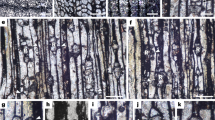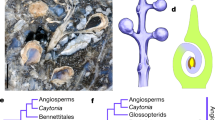Abstract
DURING the course of an anatomical study of Pœderia fœtida, a twining shrub of these parts, belonging to the family Rubiaceæ, we found that the phellogen originates in the stem, not in the subepidermal layers of the cortex as in most dicotyledons, but in the endodermis. We have seen this in a large number of sections, cut free-hand as well as on the microtome, from various collections of the material made at Dacca. The endodermis itself is a clear and unmistakable layer easily recognized by the presence of the Caspary bands on its radial walls and forming a continuous cylinder enclosing the stelar tissues. After the first tangential division of its cells the inner layer functions as the phellogen, and the outer, together with the whole of the cortex and the epidermis, is sloughed off as cork formation advances. We would like to know if a similar condition has been noticed in any other plant and what may be the causal factors leading to it. This observation is recorded here in the hope that it will attract the attention of other plant anatomists.
This is a preview of subscription content, access via your institution
Access options
Subscribe to this journal
Receive 51 print issues and online access
$199.00 per year
only $3.90 per issue
Buy this article
- Purchase on Springer Link
- Instant access to full article PDF
Prices may be subject to local taxes which are calculated during checkout
Similar content being viewed by others
Author information
Authors and Affiliations
Rights and permissions
About this article
Cite this article
MAHESHWARI, P. An Endodermal Phellogen in the Stem of Paederia foetida Linn. Nature 156, 116–117 (1945). https://doi.org/10.1038/156116b0
Issue Date:
DOI: https://doi.org/10.1038/156116b0
This article is cited by
-
Histochemistry and function of the endodermis
The Botanical Review (1961)
Comments
By submitting a comment you agree to abide by our Terms and Community Guidelines. If you find something abusive or that does not comply with our terms or guidelines please flag it as inappropriate.



